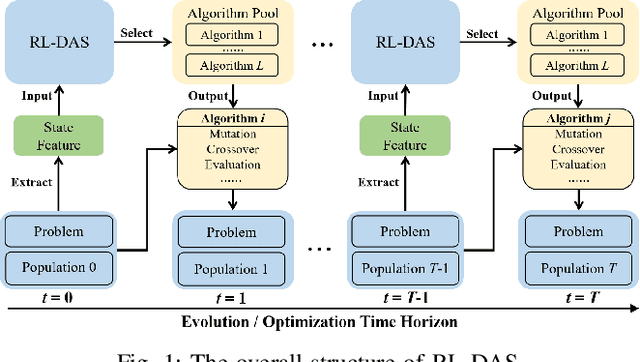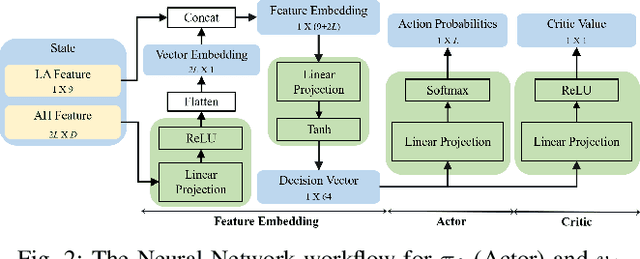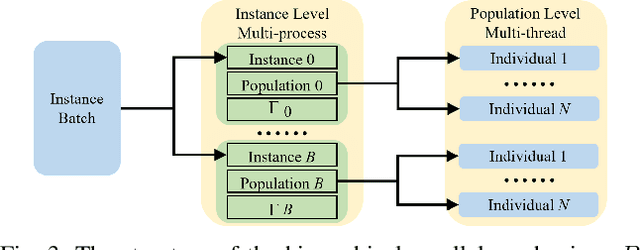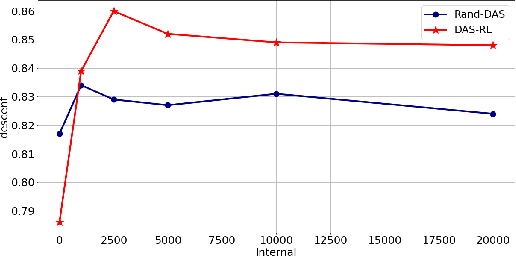Jiacheng Chen
Sherman
Feedback-Free Resource Scheduling: Towards Flexible Multi-BS Cooperation in FD-RAN
Feb 25, 2025Abstract:Flexible cooperation among base stations (BSs) is critical to improve resource utilization efficiency and meet personalized user demands. However, its practical implementation is hindered by the current radio access network (RAN), which relies on the coupling of uplink and downlink transmissions and channel state information feedback with inherent issues such as overheads and delays. To overcome these limitations, we consider the fully-decoupled RAN (FD-RAN), in which uplink and downlink networks are independent, and feedback-free MIMO transmission is adopted at the physical layer. To further deliver flexible cooperation in FD-RAN, we investigate the practical scheduling process and study feedback-free downlink multi-BS resource scheduling. The problem is considered based on network load conditions. In heavy-load states where it is impossible for all user demands to be met, an optimal greedy algorithm is proposed, maximizing the weighted sum of user demand satisfaction rates. In light-load states where at least one solution exists to satisfy all user demands, an optimal two-stage resource allocation algorithm is designed to further minimize network energy consumption by leveraging the flexibility of cooperation. Extensive simulations validate the superiority of proposed algorithms in performance and running time, and highlight the potential for realizing flexible cooperation in practice.
ConfigX: Modular Configuration for Evolutionary Algorithms via Multitask Reinforcement Learning
Dec 10, 2024Abstract:Recent advances in Meta-learning for Black-Box Optimization (MetaBBO) have shown the potential of using neural networks to dynamically configure evolutionary algorithms (EAs), enhancing their performance and adaptability across various BBO instances. However, they are often tailored to a specific EA, which limits their generalizability and necessitates retraining or redesigns for different EAs and optimization problems. To address this limitation, we introduce ConfigX, a new paradigm of the MetaBBO framework that is capable of learning a universal configuration agent (model) for boosting diverse EAs. To achieve so, our ConfigX first leverages a novel modularization system that enables the flexible combination of various optimization sub-modules to generate diverse EAs during training. Additionally, we propose a Transformer-based neural network to meta-learn a universal configuration policy through multitask reinforcement learning across a designed joint optimization task space. Extensive experiments verify that, our ConfigX, after large-scale pre-training, achieves robust zero-shot generalization to unseen tasks and outperforms state-of-the-art baselines. Moreover, ConfigX exhibits strong lifelong learning capabilities, allowing efficient adaptation to new tasks through fine-tuning. Our proposed ConfigX represents a significant step toward an automatic, all-purpose configuration agent for EAs.
Reciprocal Point Learning Network with Large Electromagnetic Kernel for SAR Open-Set Recognition
Nov 07, 2024Abstract:The limitations of existing Synthetic Aperture Radar (SAR) Automatic Target Recognition (ATR) methods lie in their confinement by the closed-environment assumption, hindering their effective and robust handling of unknown target categories in open environments. Open Set Recognition (OSR), a pivotal facet for algorithmic practicality, intends to categorize known classes while denoting unknown ones as "unknown." The chief challenge in OSR involves concurrently mitigating risks associated with generalizing features from a restricted set of known classes to numerous unknown samples and the open space exposure to potential unknown data. To enhance open-set SAR classification, a method called scattering kernel with reciprocal learning network is proposed. Initially, a feature learning framework is constructed based on reciprocal point learning (RPL), establishing a bounded space for potential unknown classes. This approach indirectly introduces unknown information into a learner confined to known classes, thereby acquiring more concise and discriminative representations. Subsequently, considering the variability in the imaging of targets at different angles and the discreteness of components in SAR images, a proposal is made to design convolutional kernels based on large-sized attribute scattering center models. This enhances the ability to extract intrinsic non-linear features and specific scattering characteristics in SAR images, thereby improving the discriminative features of the model and mitigating the impact of imaging variations on classification performance. Experiments on the MSTAR datasets substantiate the superior performance of the proposed approach called ASC-RPL over mainstream methods.
MEGA-Bench: Scaling Multimodal Evaluation to over 500 Real-World Tasks
Oct 14, 2024



Abstract:We present MEGA-Bench, an evaluation suite that scales multimodal evaluation to over 500 real-world tasks, to address the highly heterogeneous daily use cases of end users. Our objective is to optimize for a set of high-quality data samples that cover a highly diverse and rich set of multimodal tasks, while enabling cost-effective and accurate model evaluation. In particular, we collected 505 realistic tasks encompassing over 8,000 samples from 16 expert annotators to extensively cover the multimodal task space. Instead of unifying these problems into standard multi-choice questions (like MMMU, MMBench, and MMT-Bench), we embrace a wide range of output formats like numbers, phrases, code, \LaTeX, coordinates, JSON, free-form, etc. To accommodate these formats, we developed over 40 metrics to evaluate these tasks. Unlike existing benchmarks, MEGA-Bench offers a fine-grained capability report across multiple dimensions (e.g., application, input type, output format, skill), allowing users to interact with and visualize model capabilities in depth. We evaluate a wide variety of frontier vision-language models on MEGA-Bench to understand their capabilities across these dimensions.
Neural Exploratory Landscape Analysis
Aug 20, 2024



Abstract:Recent research in Meta-Black-Box Optimization (MetaBBO) have shown that meta-trained neural networks can effectively guide the design of black-box optimizers, significantly reducing the need for expert tuning and delivering robust performance across complex problem distributions. Despite their success, a paradox remains: MetaBBO still rely on human-crafted Exploratory Landscape Analysis features to inform the meta-level agent about the low-level optimization progress. To address the gap, this paper proposes Neural Exploratory Landscape Analysis (NeurELA), a novel framework that dynamically profiles landscape features through a two-stage, attention-based neural network, executed in an entirely end-to-end fashion. NeurELA is pre-trained over a variety of MetaBBO algorithms using a multi-task neuroevolution strategy. Extensive experiments show that NeurELA achieves consistently superior performance when integrated into different and even unseen MetaBBO tasks and can be efficiently fine-tuned for further performance boost. This advancement marks a pivotal step in making MetaBBO algorithms more autonomous and broadly applicable.
PuzzleFusion++: Auto-agglomerative 3D Fracture Assembly by Denoise and Verify
Jun 01, 2024Abstract:This paper proposes a novel "auto-agglomerative" 3D fracture assembly method, PuzzleFusion++, resembling how humans solve challenging spatial puzzles. Starting from individual fragments, the approach 1) aligns and merges fragments into larger groups akin to agglomerative clustering and 2) repeats the process iteratively in completing the assembly akin to auto-regressive methods. Concretely, a diffusion model denoises the 6-DoF alignment parameters of the fragments simultaneously, and a transformer model verifies and merges pairwise alignments into larger ones, whose process repeats iteratively. Extensive experiments on the Breaking Bad dataset show that PuzzleFusion++ outperforms all other state-of-the-art techniques by significant margins across all metrics, in particular by over 10% in part accuracy and 50% in Chamfer distance. The code will be available on our project page: https://puzzlefusion-plusplus.github.io.
Performance Analysis of Uplink/Downlink Decoupled Access in Cellular-V2X Networks
May 10, 2024Abstract:This paper firstly develops an analytical framework to investigate the performance of uplink (UL) / downlink (DL) decoupled access in cellular vehicle-to-everything (C-V2X) networks, in which a vehicle's UL/DL can be connected to different macro/small base stations (MBSs/SBSs) separately. Using the stochastic geometry analytical tool, the UL/DL decoupled access C-V2X is modeled as a Cox process, and we obtain the following theoretical results, i.e., 1) the probability of different UL/DL joint association cases i.e., both the UL and DL are associated with the different MBSs or SBSs, or they are associated with different types of BSs; 2) the distance distribution of a vehicle to its serving BSs in each case; 3) the spectral efficiency of UL/DL in each case; and 4) the UL/DL coverage probability of MBS/SBS. The analyses reveal the insights and performance gain of UL/DL decoupled access. Through extensive simulations, \textcolor{black}{the accuracy of the proposed analytical framework is validated.} Both the analytical and simulation results show that UL/DL decoupled access can improve spectral efficiency. The theoretical results can be directly used for estimating the statistical performance of a UL/DL decoupled access C-V2X network.
* 15 pages, 10 figures
Auto-configuring Exploration-Exploitation Tradeoff in Evolutionary Computation via Deep Reinforcement Learning
Apr 12, 2024



Abstract:Evolutionary computation (EC) algorithms, renowned as powerful black-box optimizers, leverage a group of individuals to cooperatively search for the optimum. The exploration-exploitation tradeoff (EET) plays a crucial role in EC, which, however, has traditionally been governed by manually designed rules. In this paper, we propose a deep reinforcement learning-based framework that autonomously configures and adapts the EET throughout the EC search process. The framework allows different individuals of the population to selectively attend to the global and local exemplars based on the current search state, maximizing the cooperative search outcome. Our proposed framework is characterized by its simplicity, effectiveness, and generalizability, with the potential to enhance numerous existing EC algorithms. To validate its capabilities, we apply our framework to several representative EC algorithms and conduct extensive experiments on the augmented CEC2021 benchmark. The results demonstrate significant improvements in the performance of the backbone algorithms, as well as favorable generalization across diverse problem classes, dimensions, and population sizes. Additionally, we provide an in-depth analysis of the EET issue by interpreting the learned behaviors of EC.
MapTracker: Tracking with Strided Memory Fusion for Consistent Vector HD Mapping
Mar 23, 2024



Abstract:This paper presents a vector HD-mapping algorithm that formulates the mapping as a tracking task and uses a history of memory latents to ensure consistent reconstructions over time. Our method, MapTracker, accumulates a sensor stream into memory buffers of two latent representations: 1) Raster latents in the bird's-eye-view (BEV) space and 2) Vector latents over the road elements (i.e., pedestrian-crossings, lane-dividers, and road-boundaries). The approach borrows the query propagation paradigm from the tracking literature that explicitly associates tracked road elements from the previous frame to the current, while fusing a subset of memory latents selected with distance strides to further enhance temporal consistency. A vector latent is decoded to reconstruct the geometry of a road element. The paper further makes benchmark contributions by 1) Improving processing code for existing datasets to produce consistent ground truth with temporal alignments and 2) Augmenting existing mAP metrics with consistency checks. MapTracker significantly outperforms existing methods on both nuScenes and Agroverse2 datasets by over 8% and 19% on the conventional and the new consistency-aware metrics, respectively. The code will be available on our project page: https://map-tracker.github.io.
Deep Reinforcement Learning for Dynamic Algorithm Selection: A Proof-of-Principle Study on Differential Evolution
Mar 07, 2024



Abstract:Evolutionary algorithms, such as Differential Evolution, excel in solving real-parameter optimization challenges. However, the effectiveness of a single algorithm varies across different problem instances, necessitating considerable efforts in algorithm selection or configuration. This paper aims to address the limitation by leveraging the complementary strengths of a group of algorithms and dynamically scheduling them throughout the optimization progress for specific problems. We propose a deep reinforcement learning-based dynamic algorithm selection framework to accomplish this task. Our approach models the dynamic algorithm selection a Markov Decision Process, training an agent in a policy gradient manner to select the most suitable algorithm according to the features observed during the optimization process. To empower the agent with the necessary information, our framework incorporates a thoughtful design of landscape and algorithmic features. Meanwhile, we employ a sophisticated deep neural network model to infer the optimal action, ensuring informed algorithm selections. Additionally, an algorithm context restoration mechanism is embedded to facilitate smooth switching among different algorithms. These mechanisms together enable our framework to seamlessly select and switch algorithms in a dynamic online fashion. Notably, the proposed framework is simple and generic, offering potential improvements across a broad spectrum of evolutionary algorithms. As a proof-of-principle study, we apply this framework to a group of Differential Evolution algorithms. The experimental results showcase the remarkable effectiveness of the proposed framework, not only enhancing the overall optimization performance but also demonstrating favorable generalization ability across different problem classes.
 Add to Chrome
Add to Chrome Add to Firefox
Add to Firefox Add to Edge
Add to Edge